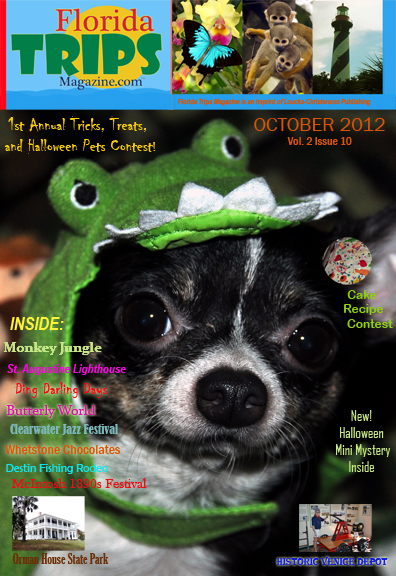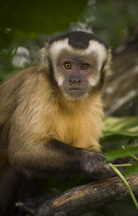Northwest Florida
Central Florida
Southeast Florida
Southwest Florida
Site Links:
Historic Lodging
Advertise


OCTOBER 2012 Monkey Jungle – Miami
Vol 2 Issue 10 by SueAnn Carpenter
OCTOBER 2012 Florida Trips Magazine Feature
Monkey Jungle
by SueAnn Carpenter
Photos used by permission © 2012 Rick Gomez
In
1933 Joseph DuMond, an animal behaviorist, released six Java monkeys
into the wilds of a dense South Florida hammock. Today there’s over 80
in that troop at Monkey Jungle. This is the home to nearly 400 primates,
with over 30 species represented, most running free on this 30-acre
reserve. It is one of the few protected habitats for endangered primates
in the United States and the only one where the general public can
explore and monkey around.
Nothing
restrains the antics of these monkeys as they swing, chatter, and play.
It’s a reverse culture where you’re in the cage and the monkeys run
free. You’ll walk through a maze of enclosures (to protect you from
bites but not errant droppings), while monkeys run around on all sides.
There are cans suspended by chains, in which you put raisins as a treat.
You'll see rare Brazilian golden lion tamarins and Asian macaques.
Screened-in trails wind through acres of "jungle," and their daily
shows feature the talents of the park's most progressive pupils.The
staff is friendly and knowledgeable. The shows are entertaining and
educational with questions encouraged.
The Java monkeys
forage on natural foods and are skilled divers in the wild, collecting
crabs and other shellfish along the riverbanks and mangrove swamps.
Their scheduled feedings show off their water skills as they dive into a
pool to receive fruit from the guides.


Amazonian Rainforest Feeding Schedule: 11:30 am, 1:45 and 4 pm
Hundreds of different species of these plants, trees, and palms came from within a 100-mile radius of Iquitos, Peru, where it rains about 180 inches a year. Monkey Jungle’s irrigation system replicates this habitat. As in the wild, there are predators here, including hawks, raccoons, and yellow rat snakes. But they are fair game as well, because some monkeys, such as Coco and his group will eat meat which includes baby raccoons and opossums. Three species of monkeys reside here. They come and go as they please, which makes this an ideal place for scientific study of primates.
The Howlers
are the largest animals here. Jordan is the largest and is brown.
Ruby is smaller and a light golden brown. The howl actually sounds more
like a roar than a howl. This is Jordan’s territorial sound telling all
the other animals in the forest where he is and that they should stay
clear. If he’s set off (when low-flying planes, thunderstorms, or a
large group of people invade his territory) you’ll hear him from a mile
away. His bony voice box looks like an oversized pouch below his chin.
Their tails are prehensile (only found in monkeys from South and Central
America.) It means they can grasp objects or branches to hold their
full body weight while they are feeding. The last 6-9 inches of the
underside of his tail is just skin--containing unique fingerprints. They
grasp objects as small as grapes so their tails function as third
hands.
Black-Capped Capuchins are
the largest type of monkey with black tufted fur on their heads (like
the peaked cowls of Capuchin monks.) Once popular as organ grinder
monkeys, they’re considered the most intelligent of New World primates
because they often use and make tools in the wild.
Squirrel Monkeys are
the most abundant here, with about 125 of these small yellow monkeys.
At one time, they were imported extensively into the United States as
research animals and as pets. For most of the year, squirrel monkeys
live in single sex groups, with females being the dominant sex. When
you see them together now it’s because they feed at the common feeding
stations. Afterward they go their separate ways. January and February
is their breeding season, when the males’ surge in hormones causes a
weight increase of almost 20%. Females have the black fur on their
heads, while the males’ fur is gray.
Hangin with the Orangs
Presentations at: 10:45 am, 1 pm, and 3:15 pm
Meet the Orangutan family, as their ape trainer takes you through a training session.
Wild monkey swimming pool Presentations at: 10 am, 12:15 pm, 2:30 pm, and 4:30 pm.
Watch monkeys wade and dive into the pool for"treats." Be prepared for the humidity, smell, flies, and mosquitoes.
Together with Wings of Love Foundation, there’s a sanctuary here for captive parrots
that are displaced or can no longer be cared for by their owners. They
are housed in huge, free-flight geodesic domes with suitable companions
and grouped with other native species from their particular region of
the world. The domes are furnished with natural foliage to add interest
and security for the birds. These birds will not be sold or bred for
commercial purposes.
Frequent
visitors are scientists and anthropologists. In fact, an interesting
archaeological exhibition excavated in 1994 from a Monkey Jungle
sinkhole displays 10,000-year-old artifacts, including human teeth and
animal bones from animals such as the saber tooth tiger, dire wolf,
Pleistocene horse and camel. It represents the largest find in South
Florida.
Monkey Jungle is located at 14805 SW 216 Street in Miami. Hours: Daily 9:30 am - 5pm. Admission: Adults-$29.95; Senior 65+ Discount -$27.95; Children (3-9)-$23.95. No charge for children under age 3. Tax not included. No parking fee. Special birthday packages, tours and annual membership offered.Call:(305) 235-1611 or go to www.monkeyjungle.com
|
Publisher: Stories Inside: Bonus: |
© 2010-2012 Lisa Loucks Christenson, Florida Trips Magazine. All Rights Reserved. Florida Trips Magazine is an Imprint of Loucks-Christenson Publishing.
Our trademarks followed by ® are registered trademarks of Lisa Loucks Christenson in the United States; those followed by ™ are trademarks or common law marks of Lisa Loucks Christenson in the United States, and may not be used in any way or form, reproduced in any way, quoted, archived, redistributed, used in any malicious way, used on any website, stored on or in any electronic system or storage media such as flash cards, CDs, DVDs, flash media, no information on this site may be copied, saved, or printed, with or without alteration in whole or in part, without prior express written permission is provided by Lisa Loucks-Christenson of PO BOX 9177, Rochester, MN 55903.
Telephone: (866) 562-5125 or (507) 226-0153. Email: publisher@FloridaTripsMagazine.com
PageViews
Florida Trips Magazine™ an Imprint of Loucks-Christenson Publishing, published monthly and available online, paperback, and hardback formats. An annual edition is planned.